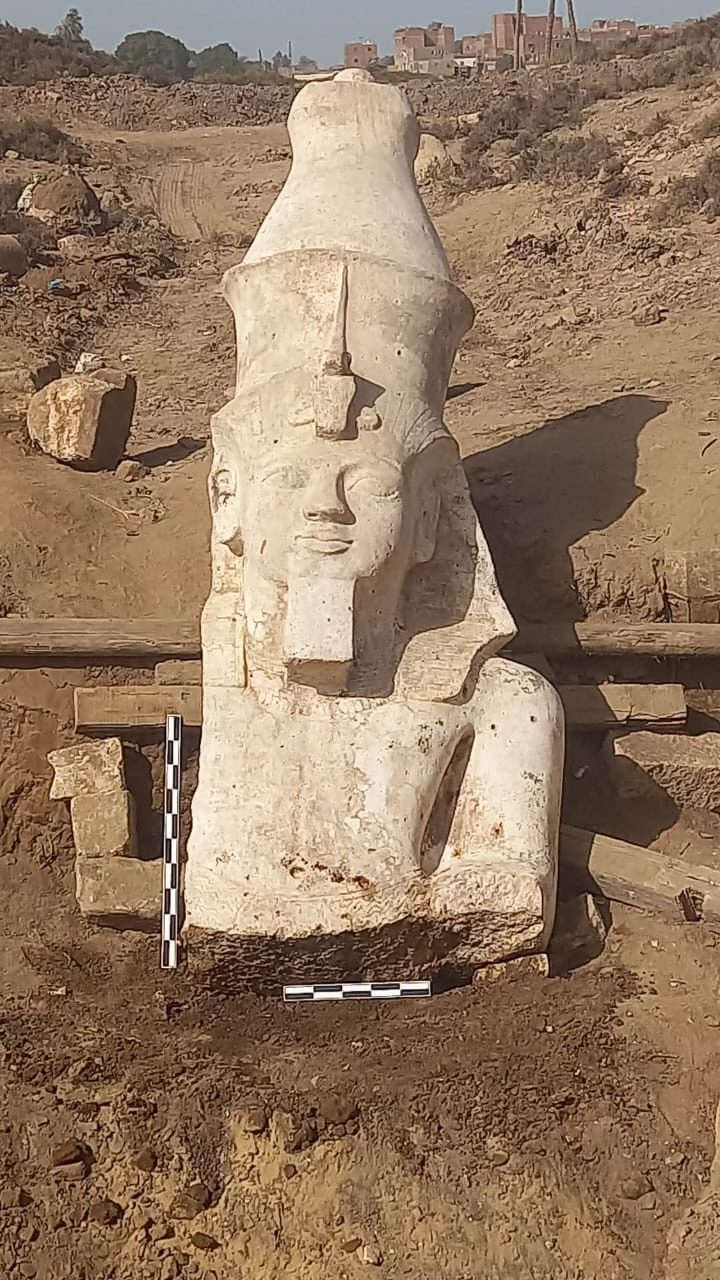A team composed of experts in the archaeology of Egypt and researchers from theUniversity of Colorado has discovered, after a year of excavations at the El Ashmunein site, south of the Egyptian city of Minya on the west bank of the Nile, the upper section of a limestone sculpture of Rameses II, featuring the head and bust of the pharaoh who lived around 1200 B.C. In ancient times the city of El Ashmunein, was known as Khemnu and in Greco-Roman times was the regional capital of Hermopolis Magna. The discovery was announced by the Egyptian Ministry of Antiquities.
The upper section, 3.8 meters high, depicts the head, shoulders and upper torso of the pharaoh. Rameses is depicted wearing the double crown indicating his rule over both the upper and lower kingdoms of Egypt, while a cobra, the symbol of kingship in ancient Egypt, is visible on the front of the crown. Preliminary scans of the limestone block confirmed that it is part of the statue of Rameses II unearthed in 1930 by German archaeologist Gunther Roeder. Once the two parts are joined, the statue is expected to reach seven meters, said Dr. Bassem Gehad, head of the Egyptian team that took part in the excavation mission. Currently, archaeological work is focused on cleaning the face of Ramses II. At a later stage, a digitization process will be used to recreate an approximation of the sculpture’s original appearance, linking sections dating back to 1930 and 2024 using computers, without compromising the integrity of the historical artifacts. Rameses II, was the third pharaoh of the 19th Egyptian dynasty and ruled from 1,279 to 1,213 BCE. Researchers explained that the excavation at Ashmunein had begun with the aim of finding a religious complex believed to date from Egypt’s New Kingdom era (1550-1070 B.C.) before collapsing during Roman rule centuries later.

Statues of Rameses II, the longest-reigning pharaoh and one of the most depicted figures of ancient Egypt, draw visitors to numerous historic sites around the country, including the double temples at Abu Simbel in Egypt’s southernmost province of Aswan. The four giant statues of Rameses II that line the main entrance to the complex, each 20 meters high, gained international fame in the 1960s during an operation to move the temples to higher ground to prevent them from being submerged by Lake Nasser, the reservoir of the Upper Aswan Dam. In addition, thousands of tourists visit the temples to see the sun illuminate a wall carving of Ramses II in a small chamber inside twice a year. Another statue of Ramses II once stood in a busy plaza in downtown Cairo near the main train station, both named after the pharaoh, before it was moved to become the centerpiece of the main hall of the Great Egyptian Museum, a vast complex near the Giza Pyramids, under construction since 2002 and nearing completion. The mummy of Ramses II, along with the remains of 21 other ancient kings and queens, was moved from the Egyptian Museum in Cairo’s Tahrir Square to the Grand Egyptian Museum near the Pyramid of Giza in 2021 accompanied by a lavish costume parade.
“Through each discovery made at the site we have been able to trace the changes in style over the very long reign of Ramses II,” the researchers said.
“Even though we did not find the complex we were initially looking for, a statue of such importance is a sign that we are digging in the right place,” said Adel Okasha, antiquities official who supervised the excavation.
 |
| Egypt, upper section of a large statue of Ramses II found |
Warning: the translation into English of the original Italian article was created using automatic tools. We undertake to review all articles, but we do not guarantee the total absence of inaccuracies in the translation due to the program. You can find the original by clicking on the ITA button. If you find any mistake,please contact us.